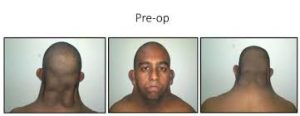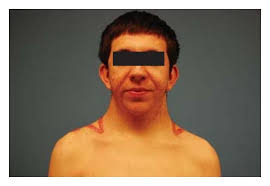

Webbed neck-Pterygium colli deformity
A webbed neck, or pterygium colli, is a congenital skin fold that runs along the sides of the neck down to the shoulders.
It has many variants.
Associated conditions It is a feature of Turner syndrome, only found in girls, and Noonan syndrome,as well as the rarer Klippel–Feil syndrome, or Diamond–Blackfan anemia.
Turner syndrome is a leading cause of a webbed neck, resulting from congenital lymphedema and residual skin folds, and is frequently associated with other features such as short stature, delayed puberty, cardiac anomalies, notably coarctation of the aorta, and renal anomalies.
Webbed neck as a classic feature in Turner syndrome, often accompanied by a low posterior hairline and lymphedema.
Noonan syndrome is another common genetic cause with webbed neck, short stature, characteristic facial features, and congenital heart defects, especially pulmonary valve stenosis.
RASopathies, including Noonan syndrome, are characterized by variable expressivity and may also include cryptorchidism and skeletal anomalies.
Klippel-Feil syndrome is defined by congenital fusion of cervical vertebrae, leading to a short, webbed neck, low posterior hairline, and limited neck mobility.
Associated findings may include facial asymmetry and risk of neurologic complications due to spinal cord involvement.
Down syndrome can present with excess nuchal skin, but true webbing is less typical.
Fetal alcohol spectrum disorder may rarely present with redundant nuchal skin, but webbed neck is not a classic feature.
Multiple pterygium syndrome is characterized by webbing (pterygia) of the neck and other joints, often with contractures and distinctive facial features.
Cervical cystic hygroma or congenital lymphangioma can present as a webbed or thickened neck.
Ultrasonography is the diagnostic modality of choice.
Severe post-burn neck contractures may mimic webbing and may cause airway compromise.
